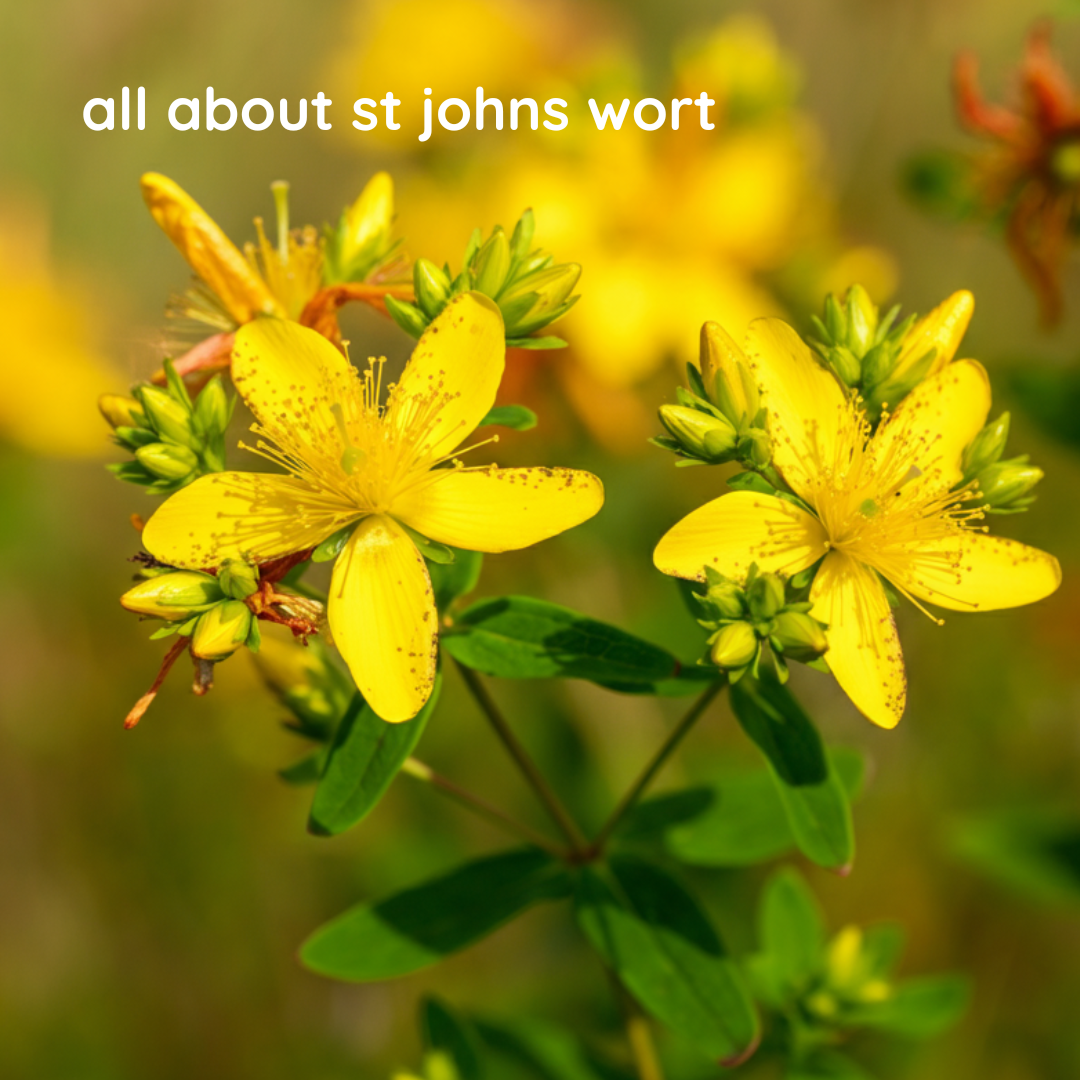Hypericum perforatum, commonly known as St. John’s Wort, is a plant with a long and storied history. Recognised for its bright yellow flowers, it has been used for centuries in traditional medicine and holds a significant place in folklore.
Description of the Plant
St. John’s Wort is a perennial herbaceous plant that typically grows to a height of 30 to 90 centimetres. It features a woody, branched root system and erect, branching stems. The stems are often reddish and have two opposite longitudinal ridges, a key identifying feature.
The leaves are stalkless, oblong, and arranged in opposite pairs along the stem. They measure between one and three centimetres in length. When held up to the light, the leaves reveal translucent dots, which are oil glands containing the plant’s active compounds. These give the species name perforatum, from the Latin for “perforated”.
From late spring to mid-summer, the plant produces clusters of star-shaped, five-petaled yellow flowers at the ends of its upper branches. Each flower is about two to three centimetres in diameter with prominent stamens. If the petals are crushed, they release a reddish-purple oil. Following the flowering period, the plant develops small, dark-red to black berries or seed capsules.
Seasonal Interest
St. John’s Wort offers visual appeal throughout much of the year, making it a valuable addition to gardens.
- Spring: In spring, the plant emerges with fresh green foliage, providing a base for the display to come.
- Summer: The peak season for St. John’s Wort is from June to August, when it is covered in a profusion of bright yellow flowers. This extended blooming period provides consistent colour in garden beds and borders. The flowers are also highly attractive to pollinators such as bees and butterflies.
- Autumn: After flowering, the plant produces decorative berries. These start as green and mature to shades of red and black, adding interest to the autumn garden and providing a food source for birds.
- Winter: While the foliage dies back in colder climates, the woody stems can provide some structural interest in the winter landscape, especially when dusted with frost.
Benefits of Cultivating St. John’s Wort
Growing Hypericum perforatum in a garden setting offers several advantages:
- Pollinator Attraction: The flowers are a rich source of nectar and pollen, attracting a wide variety of bees, butterflies, and other beneficial insects, which can help to support local ecosystems and pollinate other garden plants.
- Drought Tolerance: Once established, St. John’s Wort is relatively drought-tolerant, making it suitable for low-maintenance and water-wise gardening schemes.
- Pest and Disease Resistance: The plant is generally robust and not susceptible to many common garden pests or diseases. Its natural chemical compounds may deter some herbivores.
- Medicinal Heritage: For those interested in herbalism, growing St. John’s Wort provides access to a plant with a significant history of medicinal use, primarily for its association with mood support.
Disadvantages and Considerations
Despite its benefits, there are important considerations to be aware of when cultivating St. John’s Wort:
- Invasiveness: Hypericum perforatum can be invasive in some regions. It spreads through both seeds and creeping rhizomes, and can quickly colonise disturbed areas, outcompeting native flora. In several countries, including Australia and parts of North America, it is classified as a noxious weed. It is essential to check local regulations before planting.
- Toxicity to Livestock: The plant contains hypericin, which can cause photosensitivity in livestock, particularly in light-skinned animals. If ingested in large quantities, it can lead to skin irritation, blistering, and other health issues when the animal is exposed to sunlight.
- Medical Interactions: Preparations made from St. John’s Wort are known to interact with a wide range of prescription medications, including antidepressants, birth control pills and blood thinners. Its use should always be discussed with a healthcare professional.
History and Folklore
The common name, St. John’s Wort, is tied to John the Baptist. The plant typically blooms around St. John’s Day, which is on the 24th of June. Folklore holds that the red spots appearing on the leaves are symbolic of the blood of St. John after his beheading.
Historically, its uses are well-documented. Ancient Greeks, including physicians like Dioscorides, used it for a range of ailments. It was traditionally employed to treat wounds, burns, and nerve pain, earning it names such as “the devil’s scourge” because it was believed to ward off evil spirits. During the Middle Ages, it was hung in doorways and windows to protect households from malevolent forces and lightning.
The plant’s association with light is also prominent in its folklore. The bright yellow flowers were thought to capture the power of the sun, and it was used to bring light into the “darkness” of the mind, a belief that foreshadows its modern use for mood-related conditions.
A Plant of Sun and Story
Hypericum perforatum is more than just a common wildflower; it is a plant with deep historical roots and distinct characteristics. Its bright, sunny flowers offer significant seasonal interest and support local wildlife, making it an attractive choice for gardeners. However, its potential for invasiveness and toxicity requires responsible cultivation.
For those looking to add a plant with a rich backstory and reliable summer colour to their garden, St. John’s Wort is a compelling option. By understanding its nature and managing it appropriately, gardeners can enjoy the beauty and heritage of this ancient and fascinating plant.
Further Reading: All About the Common Poppy, The Saffron Crocus: More Than Just a Spice, All About Heather (Calluna vulgaris)
